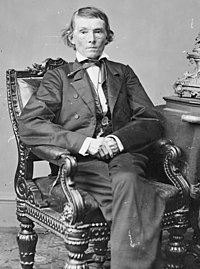Vice President of the Confederate States
| Vice President of the Confederate States of America |
|
|---|---|

|
|
| Style | The Honourable |
| Residence | Court End |
| Appointer | Electoral College |
| Formation | February 18, 1861 |
| First holder | Alexander H. Stephens |
| Final holder | Alexander H. Stephens |
| Abolished | May 10, 1865 |
The Vice President of the Confederate States of America was the office held by Alexander H. Stephens of Georgia, who served under President Jefferson Davis of Mississippi from February 18, 1861 to May 11, 1865. Having first been elected by the Provisional Confederate States Congress, both were considered provisional office-holders until they won the presidential election of November 6, 1861 without opposition and inaugurated on February 22, 1862.
According to the Confederate States Constitution, the Vice President's office was almost entirely identical to that of the Vice President of the United States.
The Vice President was elected by an electoral college (closely modeled after the U.S. Electoral College) along with the President. If no candidate won a majority in the Electoral College, the Confederate Senate would elect the Vice President from the top two vote-getters. Candidates for President and Vice President could not be citizens of the same state. Like the President, the Vice President had to be a natural-born citizen of the Confederacy or a natural-born citizen of the U.S. born prior to December 20, 1860, and a resident in the Confederacy for over 14 years.
The major difference between the U.S. and the C.S. Vice Presidencies was that the Confederate term in office was six years long. The President was explicitly forbidden from running for a second term by the constitution, but the Vice President was not. It was unclear whether or not a Vice President, who became President in the middle of a term, could run for his own term afterward.
The Vice President's primary duty was presiding over the Confederate Senate and breaking tied votes, as the U.S. Vice President presides and breaks ties in the U.S. Senate. He was also the first person in the line of succession. If the President died, resigned or was removed from office, the Vice President would become the new president for the remainder of his term. This never happened.
...
Wikipedia

